The Best Deals on Camping, Backpacking and Outdoor Gear [June 2025]
Watch this video directly on YouTube.
Barefoot hiking sandals! We love ‘em! Yup, even Josh, whom I dragged me into the barefoot world and showed the light! And now everybody on the Terradrift team has happier feet and knees. So you know we had to get our hands (feet?) on a whole bunch of barefoot hiking sandals to test this season. We wore them hiking, camping, trail running, even cycling, all to find out which ones are the absolute bomb.
And who each type is best suited for, of course. Because obviously not all feet are the same, and we all want different things in our footwear. So we’re gonna cover how these 7 barefoot sandals performed, what sort of sole thicknesses are available, what size feet they fit best, and what sort of activities each excels at. Mostly so, you know, you can feel more confident picking out the one pair you’re gonna ride or die in for the next five to ten seasons. Looking for the most up-to-date list of barefoot hiking sandals? Check out THIS POST!
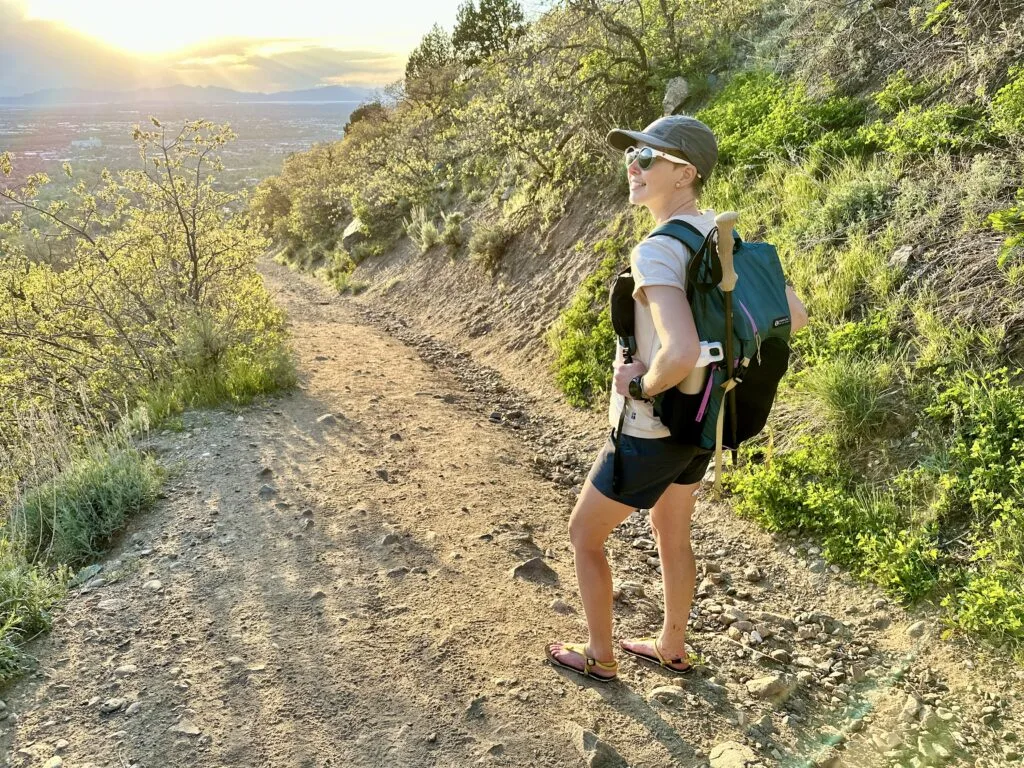
But first, a disclaimer: yes, we’re gonna talk about hiking, biking, and running in sandals. Which seems to be a hot-button issue for some of you. But it shouldn’t be, so pipe down. Listen, if you don’t want to hike in sandals, then don’t freakin’ hike in sandals. And if you run into somebody on the trail who does, it’s not your job to tell them how you feel about their footwear choices. Unless it’s to tell them how extreme they are, coupled with a look of reverence and awe. That we approve of.
We know, there are slightly more risks when hiking in sandals instead of boots, but if it’s something you want to do, and you’ve transitioned to barefoot shoes, and your feet are strong and comfortable in hiking sandals, then do it. That’s what these sandals were designed for, after all. These are purpose-built for trails.
Always hike smart, of course, no matter your footwear choice, but if you want to hike in sandals, like I do about 98% of the time it’s warmer than 60º (yup, even on rocky trails), then here are some of our faves that are both vegan and more sustainable in some way.
Barefoot Hiking Sandals

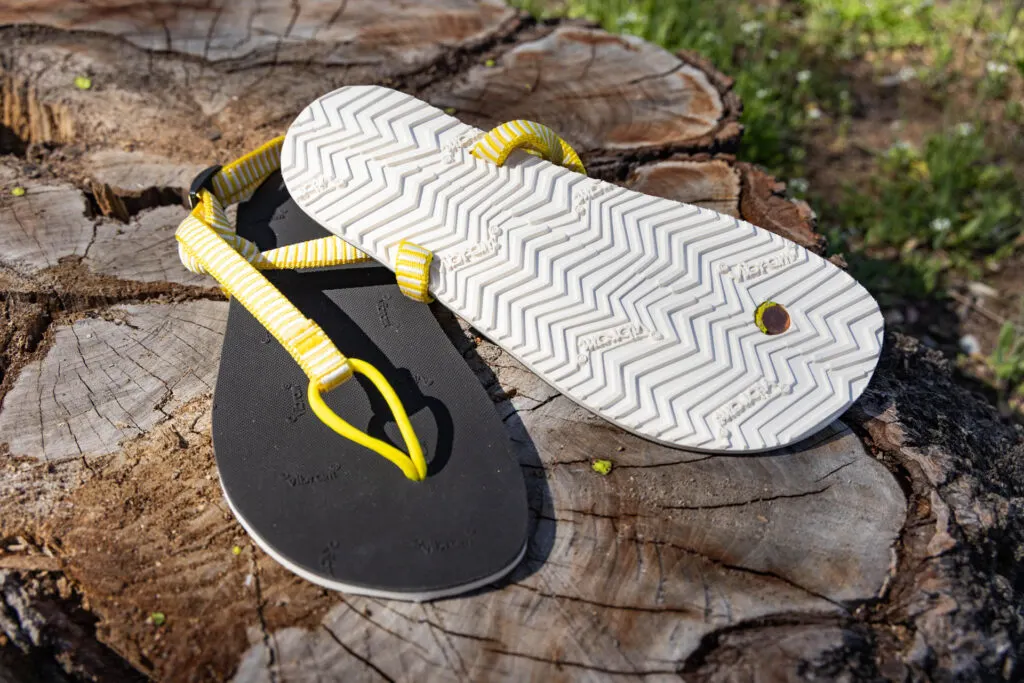
Deliberate Life Designs Onsight Sandal: The Custom Fit
I’ve said it before and I’ll say it again, the barefoot sandals from Deliberate Life Designs, a super small brand in Vermont, are some of my favorite ever, and frankly, their brand new sandals, which utilize upcycled climbing webbing donated by Black Diamond, have fully cemented their position in my mind. There are two models in this new lineup, the Onsight and Insight–I tested the thinner Onsight, which are 7 mm thick.
What I love most about DLD though, is that the brand not only offers different sole shapes to choose from so you can order sandals that best match the slope of your toes, but you can also get a fully custom footbed so they’re guaranteed to fit perfectly! They’ll even keep your preferences on file so if you want to order another pair in the future, you don’t have to go through the whole process again.
That makes these sandals a smidge more expensive than a few of the other options on this list, but honestly, worth it. Especially when you consider how soft and flexible these new straps are. I mean, they feel so nice. Not stiff or scratchy at all. And when paired with the extremely flexible soles with stupendous groundfeel, they’re just barefoot goodness to the max. Plus the footbed has a touch of anti-slip traction to prevent sweaty feet from sliding around. I loved them for trail running and hiking wet trails.
They’re at least as flexible as the Xero sandals but feel more secure on your foot. They’re not as easily adjustable though, and take a bit more effort to loosen and tighten if you want to take them on and off. That said, I mostly found I didn’t have to mess with the straps at all to do so. But if you prefer an easier slip-on and off sandal, these aren’t quite as functional in that department as some of the other options.
But if you like color and pattern, these are your sandals. There are a whole bunch to choose from. Seriously, I’m a big fan. These are some of my all-time faves.
Bonus: Get 10% off when you use code TERRADRIFT10.
How it’s sustainable: They’re made with repurposed climbing webbing that Black Diamond was planning to dispose of. That stuff would have just ended up in a landfill otherwise. So huzzah! Plus they’re handmade in Vermont.
Pros
- Custom footbed guaranteed to be perfect for YOUR feet
- Soft straps
- Fun colors
- Multiple sole thicknesses available
- Ultra flexible–some of the best of the bunch
- Super secure on your feet
Cons
- Thinnest footbeds aren’t quite as protective
- On the high end, price-wise
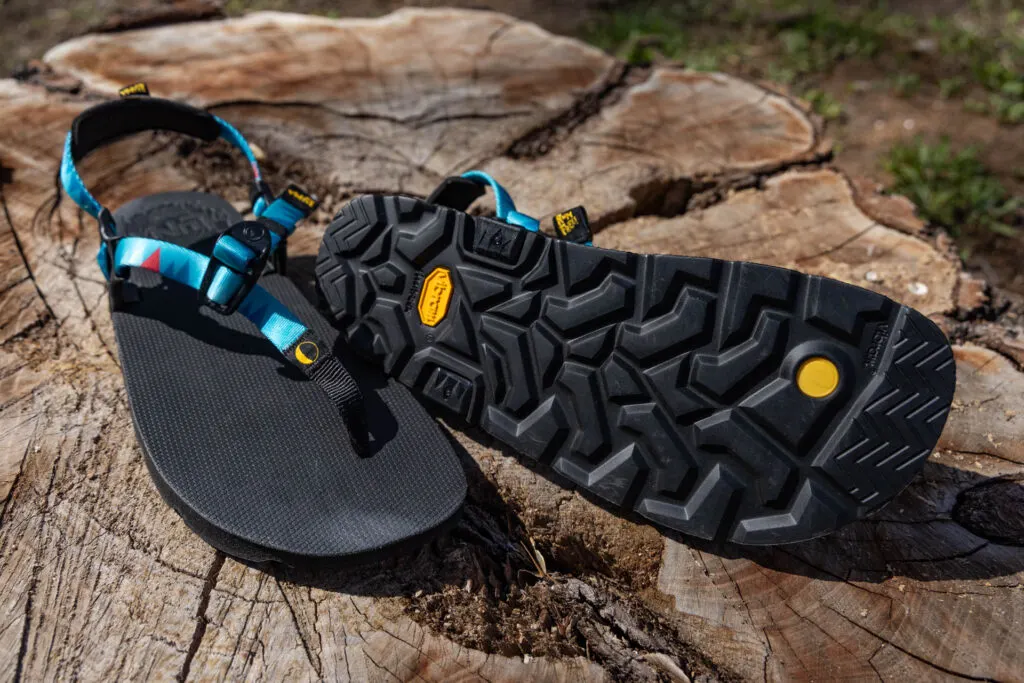
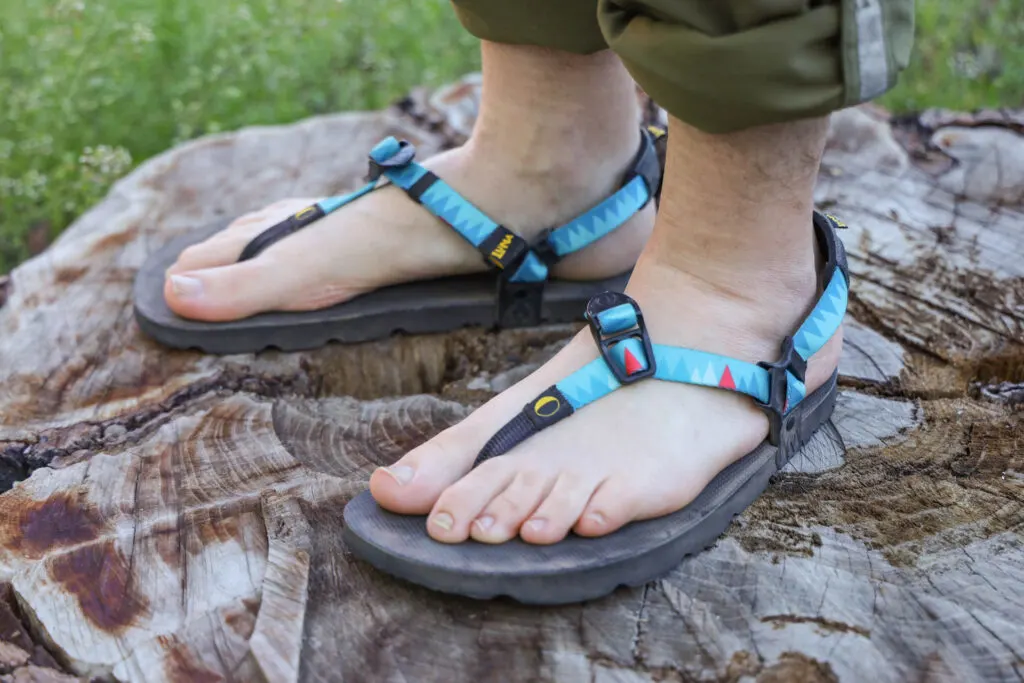
Luna Sandals Mono Winged Edition: The Comfort Kingpin
The Luna Sandals Mono is one of the brand’s best sellers. And while I have tried Lunas before–albeit with a different sole–and found them super comfortable, they felt a bit wide for narrower feet. I just couldn’t get them to hug my instep like I wanted so they slid around too much on my feet. But Josh now understands why I thought they were still great sandals: The footbed is comfortable and despite how thick the soles are–15mm–they are actually surprisingly flexible.
The straps are thin and soft, so pretty dang comfortable, but still feel tolerably durable, and the toe plug is probably the least irritating of any of the sandals Josh tested. The sole is a bit different on these. Instead of being solid rubber, they’re a dense foam-rubber compound. It’s weird, but it’s super light and it works. I am curious to see how they hold up after a season or two, though. Since the soles are a bit softer, it seems like they’re gonna wear out faster, especially if you’re running on rocky trails. I can see the Oso Flaco sole, which we tested last time, being more durable.
I do think the Lunas are the most comfortable right out of the gate. I mean, the padded heel strap was a nice touch. It took Josh a bit longer to get the fit dialed in initially since it’s just one continuous strap that you have to push and pull to get everything in the right place, but once he did, it was easy to get them on and off and tighten them via that top cinch strap, so no complaints.
These might be Josh’s favorite sandals overall, honestly.
How it’s sustainable: Made in the USA and they come with a 1-year warranty against defects and can often be repaired.
Pros
- Super Flexible
- Fairly aggressive tread
- Available in several sole thicknesses
- Comfortable footbed
- Uber comfortable webbing between your toes
- Easy on, easy off with one adjustment
Cons
- Don’t fit as well on narrow feet
- Sole may wear faster than other options
- Expensive
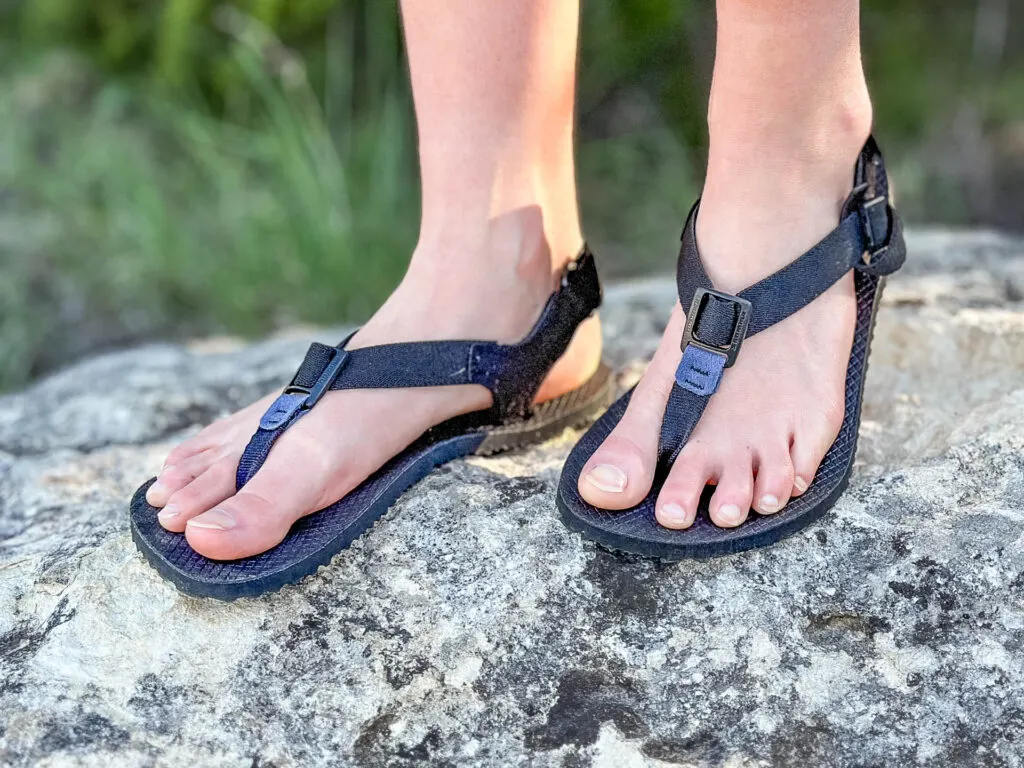
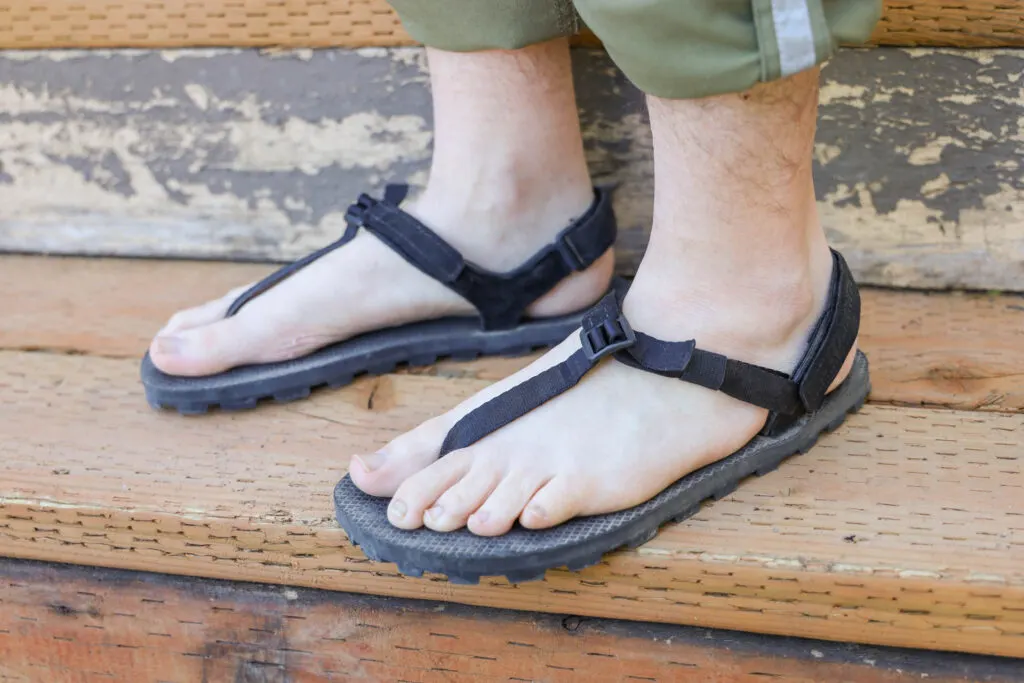
Shamma Numa Warriors + Elite Ibex : The Slip On + The Tread Beast
We tested two pairs of Shamma sandals: The Numa Warriors (Alisha) and the Elite Ibex (Josh). The Warriors have the thinnest sole from Shamma at 6mm and the Ibex is the brands newest, more rugged sole at 13mm. But both styles (Numa and Elite) are available in a variety of sole thicknesses (I tested the Trailstars Alpha a while back).
The Numa is pretty comfy on foot thanks to an elastic forefoot strap that not only lets the sandals move with your foot, but makes them super easy to slip on and off. That functionality was great, and makes them an excellent daily adventure sandal, camp sandal, that sort of thing, but they don’t perform quite as well on aggressive terrain and steep trails. You could potentially add on a power strap to help a bit, but I would reserve the Numa for easy strolls, not necessarily big hikes or trail running. They just didn’t feel as secure. My foot slid around on the footbed too much on rocky trails.
As for ground feel and flexibility, both are tops with the Warrior sole. They’re flexible, lightweight, have decent groundfeel while still being pretty protective, and really let you feel connected to the ground beneath your feet. And for that reason I’m a fan.
On all of Shamma’s sandals, the forefoot area is pretty wide, which is nice for those with wider forefeet, but the heel posts (the straps on either side of your ankle area) are actually quite narrow. They’re nice and snug, actually, which is helpful if you have a narrow heel and instep area.
The Elite Ibex has the most aggressive tread of any of the sandals we tested. But despite that, they still offered the best flexibility-to-thickness ratio, which means your feet can still move but without feeling every single tiny pokey rock you step on. So this specific sole would probably be best for those transitioning to barefoot shoes (read about how to transition here) or who like the minimalist functionality without such an extreme barefoot experience. There are other sole options available in the Elite lineup, though, if you prefer something thinner.
The three adjustment points–there’s one on the forefoot strap, the heel, and the instep–made it easy to dial in the right fit. They’re the fastest and easiest to adjust on the fly and the hook-and-loop straps helped ensure nothing loosened up or started slipping on long hikes.
They’re maybe the barefoot hiking sandals I liked least in terms of fit and comfort, though. Josh found the heel strap hit too low on his heel and the toe plug a bit uncomfortable at first. I didn’t have any problem with the toe strap, though, so it’s likely that Josh, who doesn’t wear sandals as often, just isn’t as used to the feeling.
How it’s sustainable: Shammas are repairable and made in the USA. They’re only available in black, which honestly, we don’t mind: it goes with everything, but also, only offering one color is more streamlined and less wasteful than constantly releasing new colors and patterns.
Pros
- Flexible soles
- Numa is easy-on, easy-off
- Ibex sole has deep, aggressive tread
- Wide forefoot
- Easily adjustable
- Available in a variety of sole thicknesses
Cons
- The footbed is firmer than some other options
- Only available in black
- brand-specific sizing
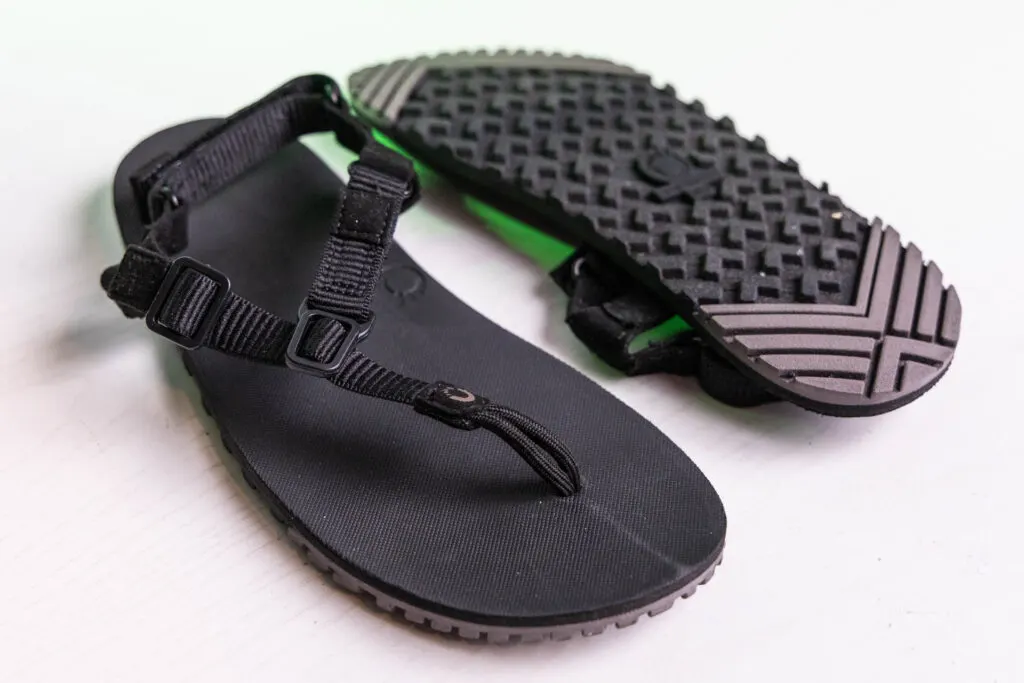
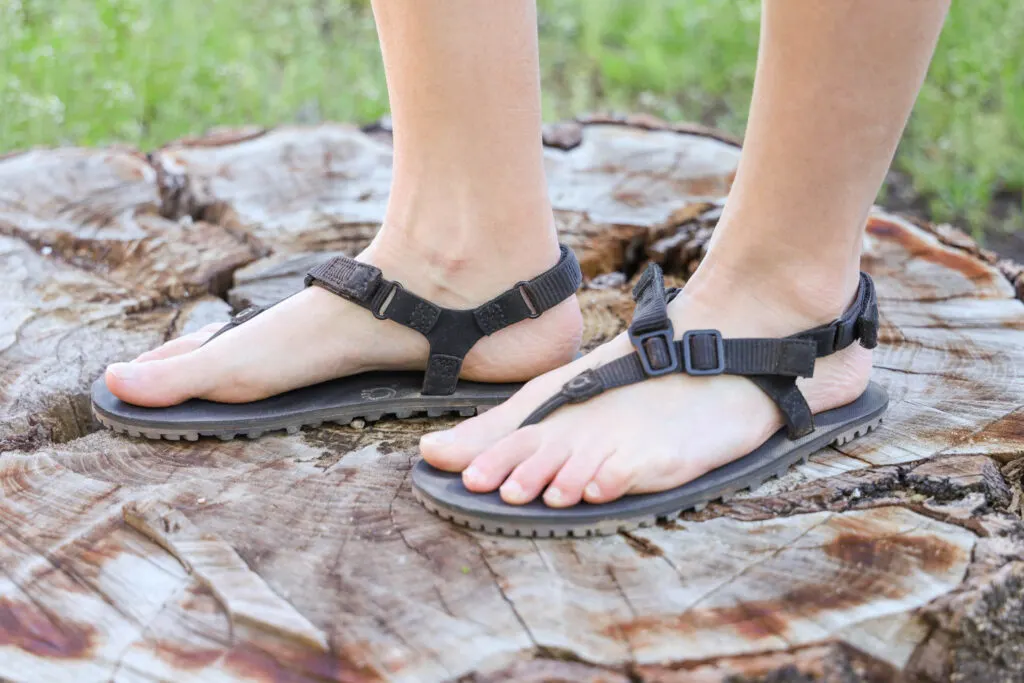
Xero Shoes H-Trail: The Light As Air Sandal
The newest barefoot hiking sandal from Xero Shoes is the H-Trail. I was actually super excited to test these because we’ve reviewed the Z-Trek and Z-Trail before, and I love those, but because they don’t have anything to stop your feet from sliding forward, they’re not designed for very aggressive terrain. They make excellent camp and soft adventure sandals, though, especially if you don’t generally like things between your toes.
But the H-Trail, they’re designed more with that classic huarache style in mind, with a thong strap to keep your foot in place. They’re super versatile and can be worn with just about anything since they’re black. They’re highly adjustable with a cinch adjustment on the outside strap and slider plus hook-and-loop on the instep and on the heel. That said, while they felt pretty secure and my feet, the tension straps did tend to loosen a bit after a while. I had to tighten them up at least once per hike.
They are stupendously flexible, though, and have just a touch of squish on the footbed for comfort, plus pretty decent lugs on the soles for how light they are–just 5.5 ounces per sandal for a women’s 7. They feel the most like wearing nothing when compared to the other sandals on this list, which I love. They’ll probably be my go-to daily and soft adventure sandals. Definitely my camp sandals when backpacking.
I will say the footbed shape is kinda weird, though. Not super foot-shaped, honestly. For me, anyway. If your second toe is longer than your first, then the shape makes a lot more sense. The heel supports are also pretty wide. My foot actually had room to slide from side to side back there, so if you have wider feet, these’ll probably fit more securely.
Since I do have skinny feet, I have both velcro straps pulled as tight as they’ll go, so the H-Trail doesn’t have the widest range of adjustability for narrow or low-volume feet. Also good to note: I wear at least a size smaller in Xero sandals than their other shoes. It’s not a deal breaker, just something to note.
How it’s sustainable: They come with Xero’s 5,000-mile sole warranty, so they’re designed to last, and that means fewer sandals in landfills.
Pros
- A touch of comfy squish in the footbed
- Hyper flexible
- Excellent groundfeel
- Good traction
- Secure
- Easily adjustable via 3 separate straps
Cons
- Footbed can feel slippery when wet
- Tend to loosen a bit over the course of a hike
- Harder to cinch down enough on thinner feet
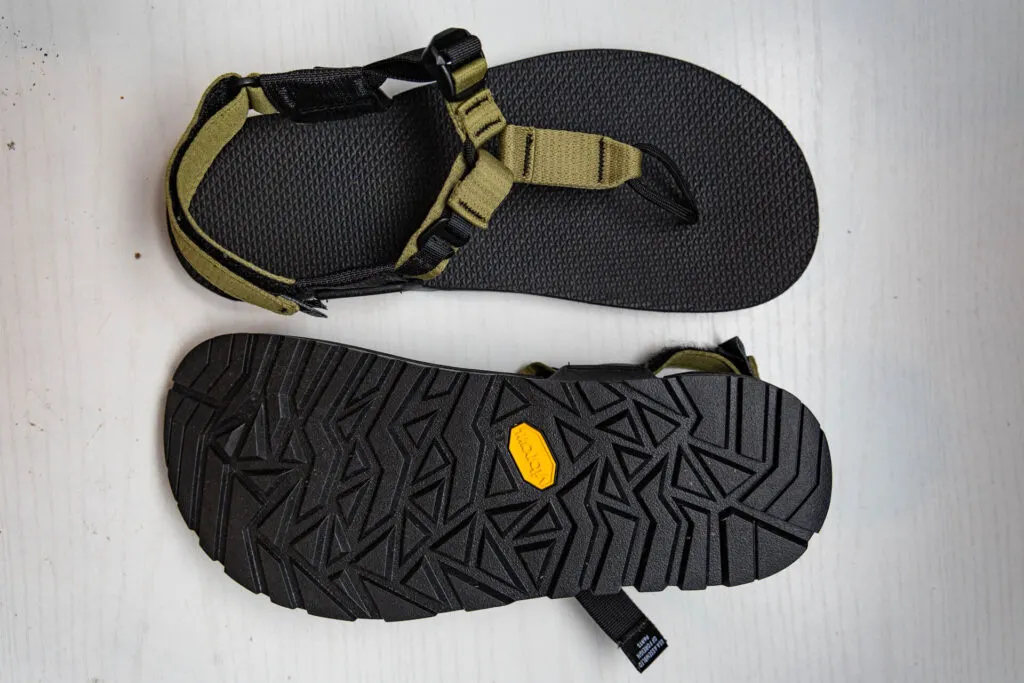
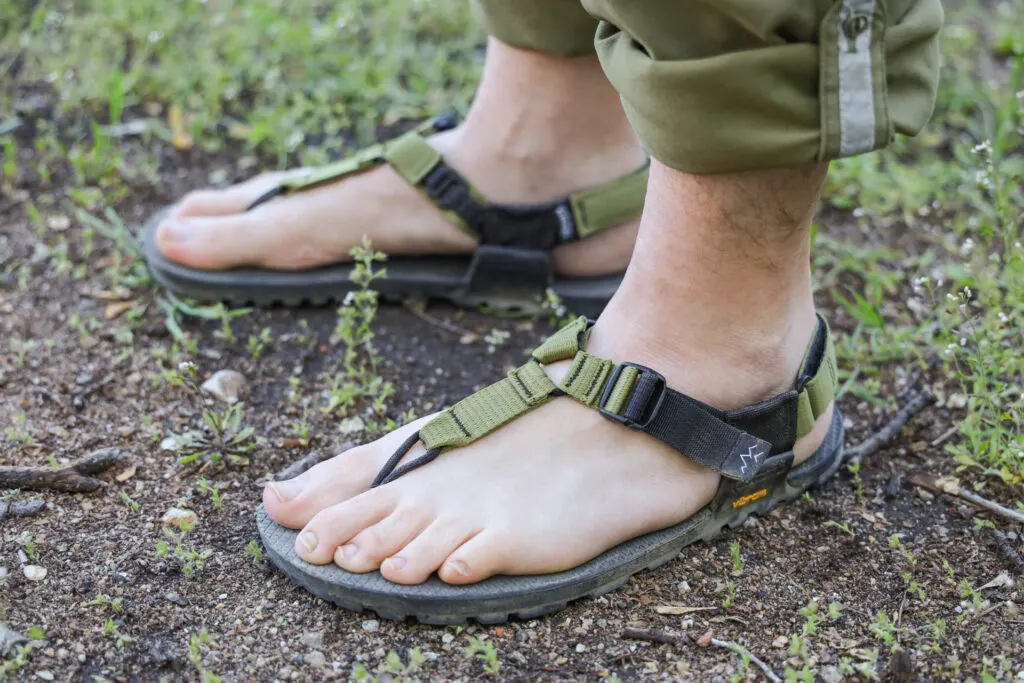
Bedrock Sandals Cairn Evo: The Durable Minimalist
The Bedrock Carin Evo sandals are more of a minimalist sandal than true barefoot sandals, which explains why they were never my favorites even though they’re a solid option (I prefer more extreme barefoot styles). Yes, they’re zero drop, offer plenty of room for toes to spread, and the regular footbed–as opposed to the 3D footbed–doesn’t feature any arch support or anything like that, but the soles are pretty thick and fairly dense, meaning they’re the least flexible we tested (but only barely).
They’re definitely burlier and more rugged with heavier-duty straps than some of these other options, so I have no doubt they’ll last for years and years. But Bedrock also offers repairs, so if the sole starts to separate or a strap gets sliced, you can send ‘em in to be fixed instead of buying a whole new pair.
They come in plenty of colors, and the straps are adjustable via hook-and-loop on the heel, a tension strap on the forefoot, and a G-hook on the instep. Basically, they’re super easy to fit to your foot and won’t go anywhere once you do.
They also got a few updates this year by way of a whole new fit and sizing system and a grippier sole. The footbed is surprisingly just a touch squishier than the Luna Mono. They feel very secure on the feet when hiking on dry or wet trails, including in water. And the sole is sticky enough that I could walk over wet stones in the river and not slip around.
The toe loop is paracord as opposed to webbing like some of the others Josh I tested, so it’s maybe not AS comfortable, but you’ll get used to it–he did. They also have the widest heel/instep of any of the sandals Josh tested, so if you have wider feet, this may be the way to go. That said, if you want the health benefits of minimalist shoes but aren’t too keen on feeling every rock and pebble under your feet with every step, these’ll be just the thing.
How it’s sustainable: Plus they’re made in the US and have a warranty for the lifetime of the sole, plus they’re repairable.
Pros
- More protective sole
- Straps are easily and individually adjustable
- Several colors available
- Super durable
- Solid warranty
Cons
- Thicker soles are more minimalist than barefoot
- Not as flexible as other options
- Most expensive
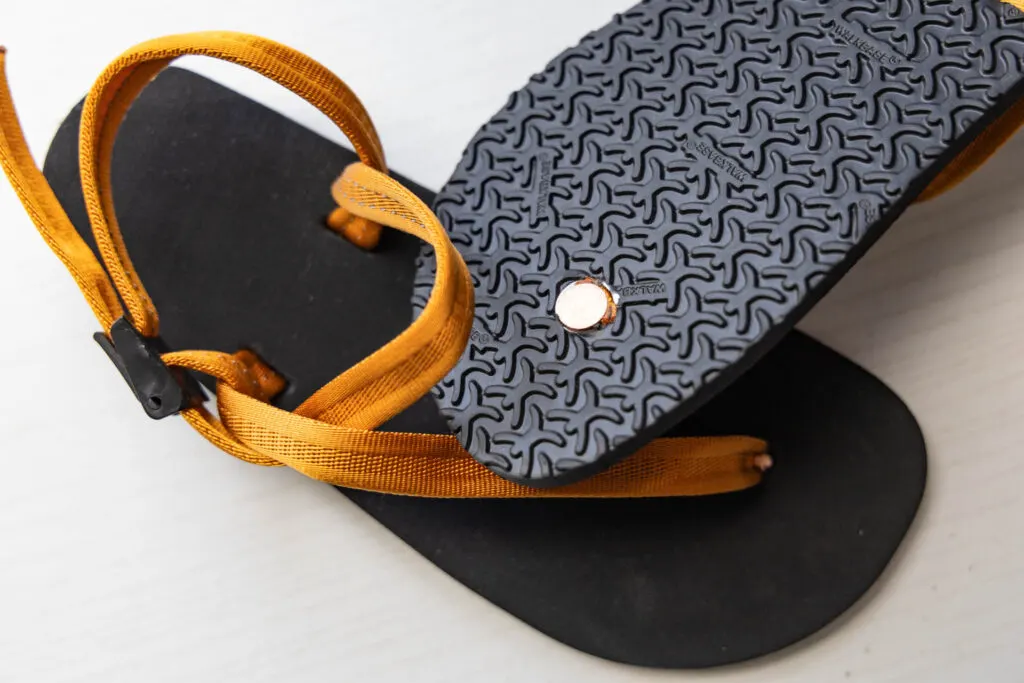
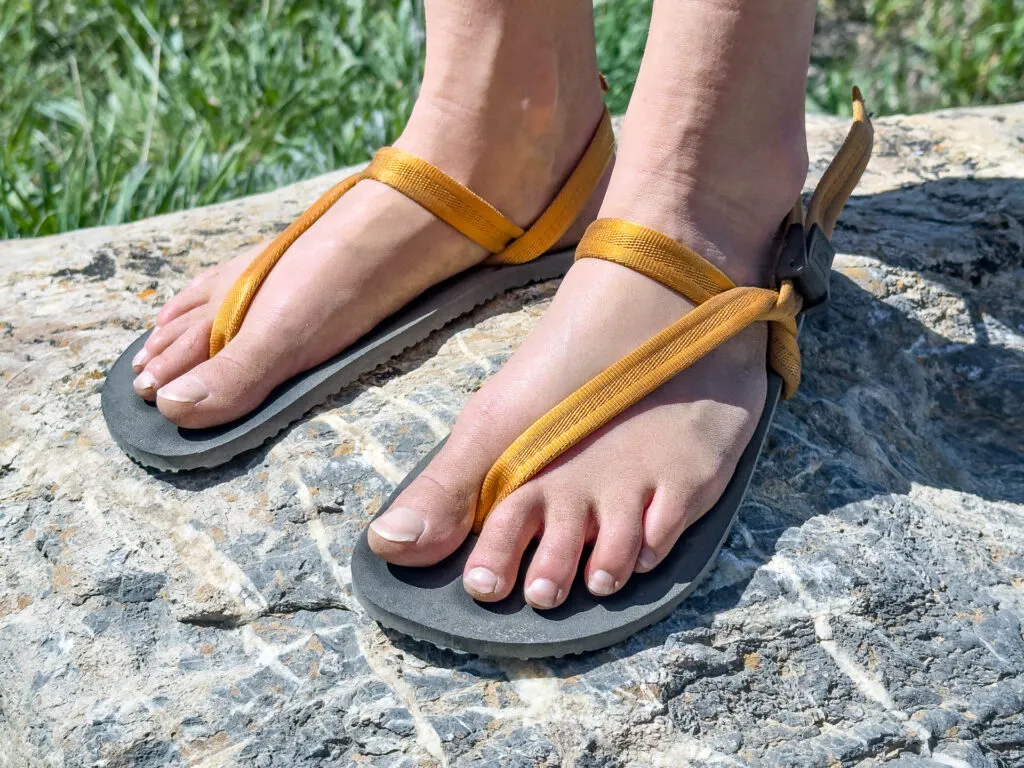
Earthrunners Primal Sandals: The Earthing Sandal
I’ve tested Earthrunners in the past, and while I’ve always liked the look, they weren’t ever my favorite. However, that might have just changed with the Eathrunners Primal barefoot hiking sandal. Because sometimes you just have to get the right footbed and strap combo and everything changes.
What makes Earthrunners unique is that they’re grounding sandals. As in, there’s a copper disc that secures the toe plug to the sole, then super thin metal wire stitching in the straps. Together, they keep you grounded. As in, they let the extremely low frequency electromagnetic resonances of the earth enter through your feet and circulate through your body, which some studies suggest could have positive effects on inflammation, among other things. At the very least give you a good mood boost. (Read more about grounding here.) Regular shoes don’t let those pulses through, so the idea is that not only will your feet be healthier and stronger in these sandals, but so will the rest of your body.
But back to performance. Because of the thickness and lack of stretch in the straps, these are some of the most secure sandals we tested. They don’t loosen even when trail running and they’re not going anywhere once they’re on your feet. That also means they might take a little longer to break in, but we think it’s worth it because between the colors and sole thicknesses available, there’s something for everyone whether you want to hike in ‘em, trail run, or just hoof it around town. Because they don’t LOOK like hiking sandals. Which is why I love them for travel.
The Primal sole is one of the brand’s thinner options at 7.5mm, and I liked them much better than the Circadian sole I tested last time, which was a bit thicker, so not as flexible, but more protective. I also went with the ergonomic lifestyle laces. The performance laces are thicker and therefore stiffer and harder to break in and soften up, but honestly, I found the lifestyle laces plenty durable and performance-ready.
These were the narrowest sandals of the bunch where the instep straps loop through, which is probably why I loved them for trail running–they’re super secure on my narrow feet–but if you have wider feet you may find them uncomfortable as you may be kinda stepping on the straps. They have one continuous strap, so they’ll take a minute to get dialed in right out of the box, but once they are, they’re really easy to tighten and loosen thanks to the adjustment clip on the side.
Honestly, these are a stellar all-arounder. Good for hiking and trail running, but also more stylish and travel-friendly. Bonus: they’re also some of the least expensive sandals on this list.
Use code TERRADRIFT to get 10% off!
How it’s sustainable: Earthrunners donates 1% of all sales to True Messages, a non-profit focused on honoring the running heritage of the Tarahumara culture and supporting the youth of the community. Buckles are made in California of 25% recycled injection-molded plastic.
Pros
- Dense but flexible sole for more protection
- Lots of lace colors and patterns available
- Super secure strap system
- Earthing/grounding capable
- Easy to adjust and take on and off
Cons
- Not the most comfy toe strap right out of the box (takes some breaking in)
A note on sizing
Sandal sizing can be all over the place. At least for me. I wear everything from a 6 in Xeros to a 7.5 in other sandals. Fortunately, almost all of these brands have printable templates–and sometimes measurement instructions if you don’t have access to a printer–to help you figure out exactly what size you need. Just pay special attention to if brands have custom or unisex sizing. For example, Bedrock and Shamma both have their own sizing, so you may not be ordering your usual numberred size. (Honestly, why can’t we just move to European sizing for footwear? So much easier.)
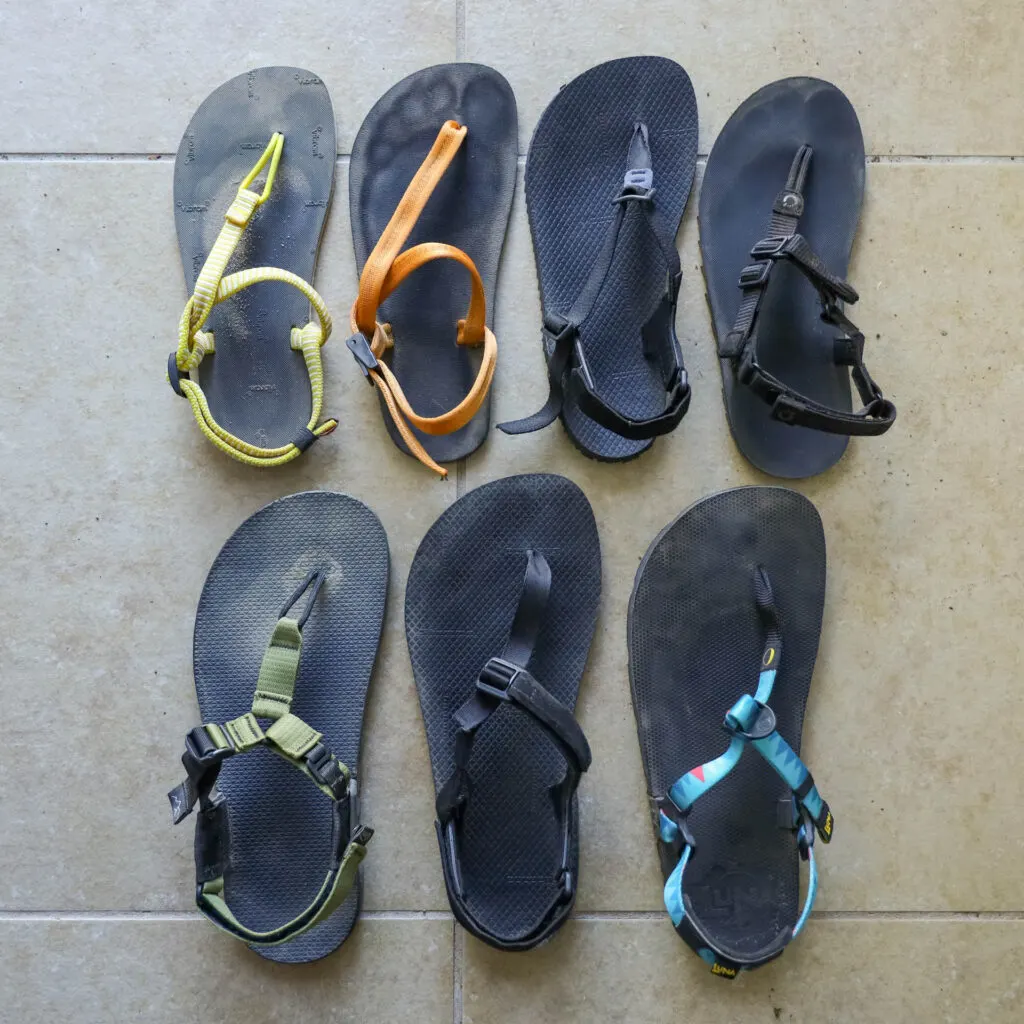
Bottom Line: Barefoot Hiking Sandals FTW!
Those are our favorite barefoot sandals for the season! If you have any questions about these adventure sandals, drop ‘em in the comments and we’d be happy to answer. We love talking about barefoot shoes. And if you’re into that, check out our other reviews of barefoot hiking boots, our favorite barefoot shoes for every season, and how to transition to barefoot shoes!
Then we’d be stoked if you shared this with a friend or two who might be into hiking sandals! Either way, strap some barefoot sandals on your feet, get outside, and wander on. Just don’t forget the sunscreen. You don’t want your toesies to burn.
Check out some other barefoot sandals for hiking in last year’s post!
This post contains affiliate links, which means when you clicky-click and make a purchase, we may receive some compensation. Don’t worry, it won’t cost you any extra, but you will be supporting Terradrift! That’s what we call a win-win!

Jojo
Tuesday 21st of May 2024
Thanks for the thorough review! what do you think about these for Morton's Neuroma?
Alisha McDarris
Friday 24th of May 2024
Our pleasure! We're not podiatrists or anything, but from what those more qualified individuals have explained to us, just about anyone can wear barefoot shoes as long as they transition slowly and carefully. The exceptions that they've told us about are folks with high, rigid arches and/or extreme pronation and/or some medical conditions, which could potentially include Morton's Neuroma. But if you're interested in barefoot shoes, we'd check in with a functional podiatrist specifically to see if they're right for you!